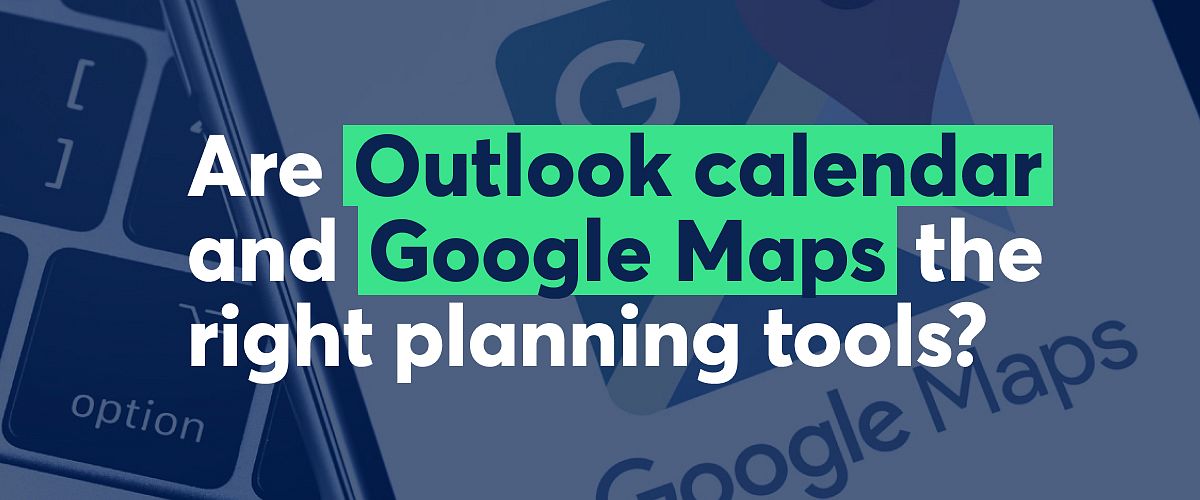Are Outlook and Google the right tools?

In the current world of field service planning and service management, Google Maps and calendars like Outlook are still widely used tools. Understandably, they are very user-friendly applications with limited costs. They offer many benefits but also have their limitations. In this blog, we will discuss whether these are the right tools for field service planning and when it's time to upgrade to advanced scheduling software.
Outlook and other calendar tools
Google Calendar and Microsoft Outlook are well-known and excellent interfaces for simple appointment scheduling and calendar management. You can quickly add or edit appointments and check the availability of employees. Often, different colors are used to indicate specific categories of tasks. You get a quick overview of multiple calendars simultaneously.
Moreover, a calendar appointment can contain a lot of information. There is a free-text field, and all the information flows directly to the appropriate field service employee.
Google Maps
Google Maps needs little explanation. Everyone knows Google Maps. It is a powerful tool for finding locations and calculating distances between two or more locations. It also provides real-time traffic information, which can be useful for urgent interventions or last-minute changes. Planners often use it to check if the distance between two different tasks is not too large.
When do these tools reach their limitations?
Google Maps and Outlook calendars offer some benefits for field service planning but also have limitations. For example, calendars do not provide automatic task allocation, and Google Maps does not offer route optimization. They are not intelligent applications that can support planners in making decisions. This means that the planning process still needs to be done manually. Planners have to search for available time slots in the appropriate employees' calendars and try to plan the optimal route for each employee themselves. This can make the planning process time-consuming and efficient planning a very challenging task. It may be feasible, especially for smaller teams or companies with simple planning requirements.
However, for growing companies, this becomes more difficult. The more calendars, the harder it is to maintain an overview. The number of calendars you can view simultaneously is limited and not scalable.
But above all, the complexity of the planning plays an important role. The more tasks an employee can perform in a day, the more difficult it becomes to plan efficient routes. And there are many other factors that can make planning more complex. Consider different skills of employees, requested time windows from customers, or other task priorities. Taking all these into account when manually searching for the right appointment time is extremely challenging. And often, this needs to be done while on the phone with the customer, adding even more stress.
Besides the size of the field service team and the complexity of the planning, there may be a third reason why calendars and Google Maps are no longer sufficient. That is the dynamic nature of the planning. Tasks that can still be rescheduled, time blocks that need to be reserved, and last-minute changes that can disrupt the planning are just a few examples that don't allow for a fixed schedule. Solving all this manually is very difficult. Experienced planners may be able to manage it, but they are difficult to replace when they are absent.
In summary, the size, complexity, and dynamics of the planning can make manual planning with calendars and Google Maps time-consuming. Finding a solution is often sufficient and more important than finding an efficient solution, which is too difficult. At that point, Google Maps, Outlook calendars, or even other limited agenda tools in ERP systems are no longer sufficient, and it is time to look for advanced scheduling software.
Advanced scheduling software
Growing companies with complex planning needs that want to increase efficiency and maximize productivity should invest in advanced scheduling software. The difference compared to limited planning tools is that this software contains much more intelligence. Everything is customized to the company's planning process. Afterward, the software can automatically plan, continuously optimize, or support planners with smart suggestions so they can make decisions quickly yet efficiently.
Advanced scheduling software offers various benefits for companies, including:
- A more efficient back office: The back office is continuously supported in planning and communicating with customers. Smart tools can drastically reduce planning time.
- Fewer errors: Advanced software can help minimize human errors by automating tasks and processes, improving the accuracy and reliability of the planning.
- Higher field service productivity: Through continuous planning optimization and route optimization, the number of kilometers and travel time decreases, giving employees more time to perform tasks at the customer's location.
- Improved customer service: The planning takes into account all customer requirements. Moreover, service delivery can be enhanced through faster response times, better customer communication, and more flexibility in the planning process.
- Real-time updates: Advanced scheduling software provides real-time updates and an overview of the current planning and progress, allowing the back office to quickly respond to last-minute changes.
Conclusion
In the current world of field service planning and service management, Google Maps and calendars like Outlook are still often used. Although these tools can be useful for small teams or companies with simple planning requirements, they have limitations and drawbacks for growing companies with more complex planning needs. Advanced scheduling software can significantly increase efficiency, employee productivity, and customer satisfaction. Think of automatic task allocation, continuous route optimization, best suggestions, alerts, real-time information, and much more. Utilizing advanced planning software will help companies optimize and improve their field service operations.

 Written by
Written by